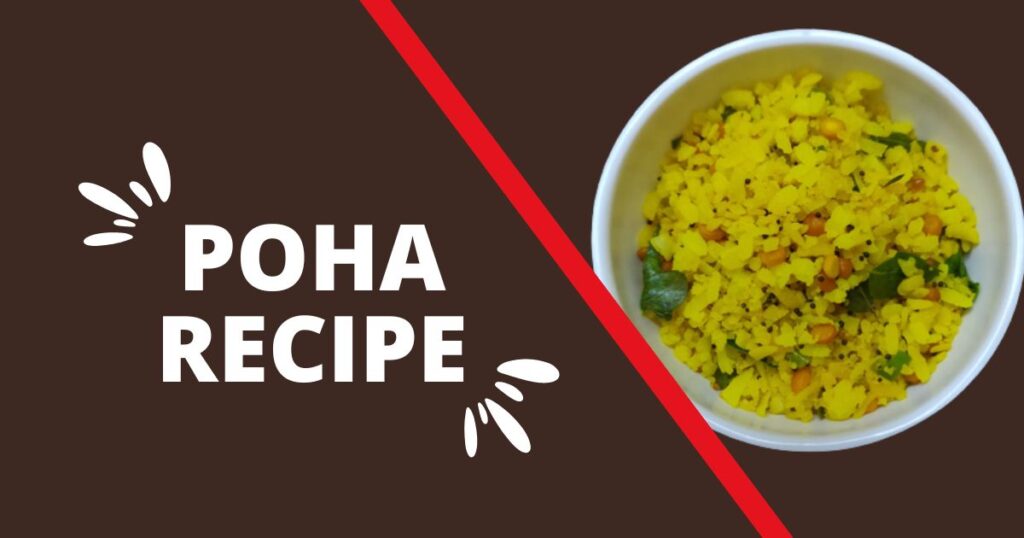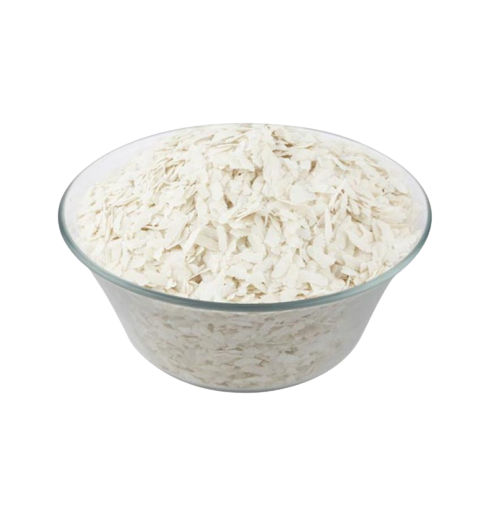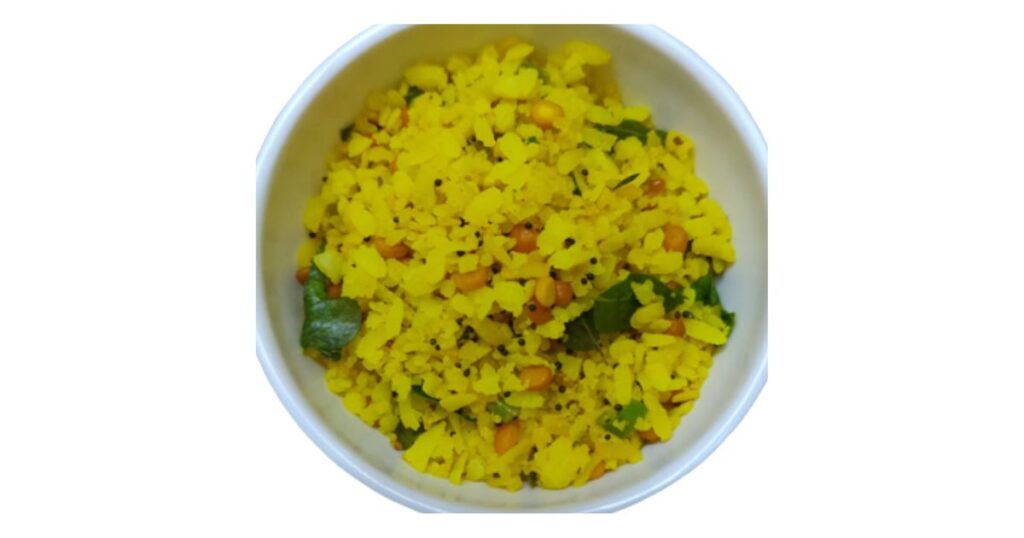In today’s fast-paced world, a quick and nutritious breakfast is a lifesaver. Poha Recipe, a traditional Indian dish, comes to the rescue as a delicious and time-efficient option. Poha, also known as flattened rice or beaten rice, is a popular breakfast choice in India.
In this comprehensive guide, we will explore the art of making Poha in just 10 minutes. We’ll delve into the recipe, ingredient variations, nutritional benefits, and some handy tips.
Poha Recipe: A Quick Breakfast in 10 minutes
Method Of Poha Recipe:
Poha, a beloved Indian breakfast dish, is a flavorful and wholesome way to start your day. Whether you’re new to cooking or a seasoned chef, making Poha at home is easy and satisfying. In this step-by-step guide, we’ll walk you through the process of creating a delicious Poha recipe that’s perfect for your morning routine.
Follow these steps to make a delicious Poha breakfast in just 10 minutes:
Ingredients:
- 1 cup Poha (flattened rice)
- 2 tablespoons cooking oil
- 1 teaspoon mustard seeds
- 1 teaspoon cumin seeds
- 1/4 cup finely chopped onions
- 1/4 cup diced potatoes (optional)
- 1/4 teaspoon turmeric powder
- Salt to taste
- 1-2 green chilies,
- 1 tablespoon lemon juice
- Fresh coriander leaves for garnish (optional)
Instructions:
1. Rinse and Soak the Poha:
- Place the Poha in a sieve or strainer.
- Rinse it under running water for 15–20 seconds until it softens.
- Drain the excess water and let the Poha sit for 5 minutes to absorb moisture.
- With a fork, gently fluff it to separate the grains.
2. Temper the Spices:
- In medium flame, heat an oil in the pan,
- Add mustard seeds and let them splutter.
- Add cumin seeds and sauté for a few seconds until they release their aroma.
- Sauté Onions and Green Chilies,
- Add finely chopped onions and green chilies.
- Sauté until the onions turn translucent.
- Sprinkle turmeric powder and salt over the mixture.
- Stir well and add the soaked Poha to the pan.
- Gently mix everything together to ensure the Poha is evenly coated with the spices.
- Cook for 2–3 minutes, allowing the flavors to meld.
3. Finish with Lemon Juice:
- Drizzle lemon juice over the Poha and give it a final toss.
- Taste the salt and spice levels if needed.
4. Garnish and Serve:
- Transfer the Poha to a serving dish.
- Garnish with fresh coriander leaves for a burst of freshness,its optional.
Your quick and delicious Poha breakfast is ready to be enjoyed! Serve it hot and savor the flavors of this classic Indian dish. Feel free to customize this recipe by adding grated coconut, roasted peanuts, or any other ingredients you love. Enjoy your meal!
Nutrition Value Of Poha Recipe:
The nutritional value of a Poha recipe can vary depending on the specific ingredients and quantities used. However, here’s a general breakdown of the nutritional components of a typical Poha recipe serving (approximately 1 cup):
- Calories: Around 250–300 calories.
- Carbohydrates: Approximately 50–60 grams, mainly from the flattened rice (Poha) and any added vegetables or potatoes.
- Protein: About 5–8 grams, with protein content varying depending on the amount of peas or other legumes used.
- Fat: Usually 5–10 grams, primarily from the cooking oil used for tempering.
- Fiber: Provides around 2–4 grams of dietary fiber, depending on the Poha’s thickness and any added vegetables.
- Vitamins: Poha is a source of B vitamins, particularly B1 (thiamine) and B3 (niacin).
- Minerals: Contains essential minerals such as iron, potassium, and magnesium.
- Antioxidants: Ingredients like turmeric, curry leaves, and coriander leaves contribute to antioxidant content.
It’s important to note that the nutritional content can vary based on factors like the type of Poha used (thicker or thinner flakes), the amount of oil, and the presence of additional ingredients like peanuts. To get precise nutritional information for your specific Poha recipe, you may want to use a nutritional calculator or refer to the nutrition labels on individual ingredients.
Additionally, Poha is considered a relatively healthy and balanced breakfast option due to its combination of carbohydrates, fiber, and some protein. It’s a popular choice in India and is suitable for individuals looking for a quick and nutritious breakfast.
Tips for Perfect Poha:
To master the art of making Poha at home, keep these tips in mind:
- Choose the Right Poha: Thick or thin, the choice is yours. Adjust the cooking time accordingly.
- Rinse Thoroughly: Properly rinsing the Poha is crucial to achieve the right texture.
- Flavorful Tempering: Don’t skimp on the spices used in the initial tempering; they elevate the dish’s taste.
- Customize to Taste: Adjust the spice levels, add veggies, or experiment with garnishes to suit your preferences.
- Fresh Ingredients: Use fresh curry leaves, green chilies, and coriander leaves for the best flavor.
Health Benefits of Poha Recipe:
Poha Recipe, a traditional Indian breakfast dish made from flattened rice, offers several health benefits:
- Rich in Carbohydrates: Poha is a carbohydrate-rich food, providing a quick source of energy, which is essential to kickstart your day.
- Low in Calories: It’s a low-calorie option, making it suitable for those looking to manage their weight while enjoying a filling meal.
- Good Source of Iron: Poha contains iron, which is important for maintaining healthy hemoglobin levels and preventing anemia.
- Rich in Vitamins: It’s a source of B-vitamins, particularly B1 (thiamine) and B3 (niacin), which are crucial for energy metabolism and overall well-being.
- Adequate Fiber: Poha contains dietary fiber, aiding in digestion, promoting a feeling of fullness, and supporting regular bowel movements.
- Gluten-Free: Poha is suitable for people with celiac disease or gluten intolerance because it is naturally gluten-free.
- Low in Sodium: For those monitoring their sodium intake, Poha can be prepared with minimal salt, contributing to a lower sodium diet.
- Customizable: Poha recipes are highly customizable. You can add vegetables, nuts, and seeds to enhance the nutritional value and flavor.
- Easy to Digest: It’s light on the stomach and easy to digest, making it a suitable option for individuals with sensitive digestive systems.
- Balanced Nutrition: Poha provides a balance of carbohydrates, protein, and a moderate amount of healthy fats, creating a well-rounded meal.
- Cultural Significance: Beyond its nutritional benefits, Poha is culturally significant in Indian cuisine, connecting people to their culinary heritage.
- Versatile: Poha can be adapted to various dietary preferences, including vegan, vegetarian, and even gluten-free diets.
- Quick and Convenient: Poha is known for its rapid preparation, making it an excellent choice for busy mornings when time is limited.
While Poha Recipe is a nutritious breakfast option, it’s essential to balance it with a variety of foods to ensure a well-rounded diet. Additionally, the specific health benefits may vary depending on the ingredients and preparation methods used in your Poha recipe.
Conclusion:
Making Poha Recipe at home is not just about preparing breakfast; it’s about experiencing the rich tapestry of Indian flavors and traditions. With this easy-to-follow guide, you can create a delightful Poha recipe that’s both satisfying and culturally enriching. Start your day on a delicious note with your very own homemade Poha.
Poha is an accessible and satisfying dish that allows you to explore the rich tapestry of Indian flavors. So, next time you’re looking for a quick, flavorful, and nutritious breakfast, consider whipping up a delicious plate of Poha and savoring the cultural and culinary richness it brings to your table.
FAQs:
1. What is Poha, and where does it originate?
Poha, also known as flattened rice, is a popular breakfast dish in India. It originates from the Indian subcontinent.
2. How do I choose the right type of Poha for my recipe?
There are two main types: thick and thin Poha. Use thick Poha for recipes where you want a softer texture and thin Poha for a more delicate, crisp result.
3. Is Poha gluten-free?
Yes, Poha is naturally gluten-free, making it suitable for those with gluten intolerance or celiac disease.
4. Can I make Poha in advance and reheat it?
Yes, you can make Poha ahead of time and reheat it in a microwave or on the stove top. Add a little water and fluff it up while reheating.
5. What are some popular variations of Poha?
Some popular variations include Kanda Poha (with caramelized onions), Batata Poha (with potatoes), and Peas Poha (with green peas).
6. Is Poha a healthy breakfast option?
Yes, Poha is considered a healthy breakfast option. It’s low in calories, contains essential nutrients, and is easy to digest.
7. Can I make Poha without using oil?
Yes, you can reduce or eliminate oil to make a healthier version of Poha. Use non-stick cookware to sauté the ingredients.
8. What are the essential spices used in Poha?
Common spices include mustard seeds, cumin seeds, turmeric powder, and green chilies. However, you can adjust the spices to your taste.
9. Can I make Poha without vegetables?
Yes, you can make a basic Poha recipe without vegetables. It will still be delicious with the spices and seasonings.
10. Is Poha only a breakfast dish, or can it be eaten at other times of the day?
While Poha is a popular breakfast choice, it can also be enjoyed as a snack or light meal at any time of the day.





